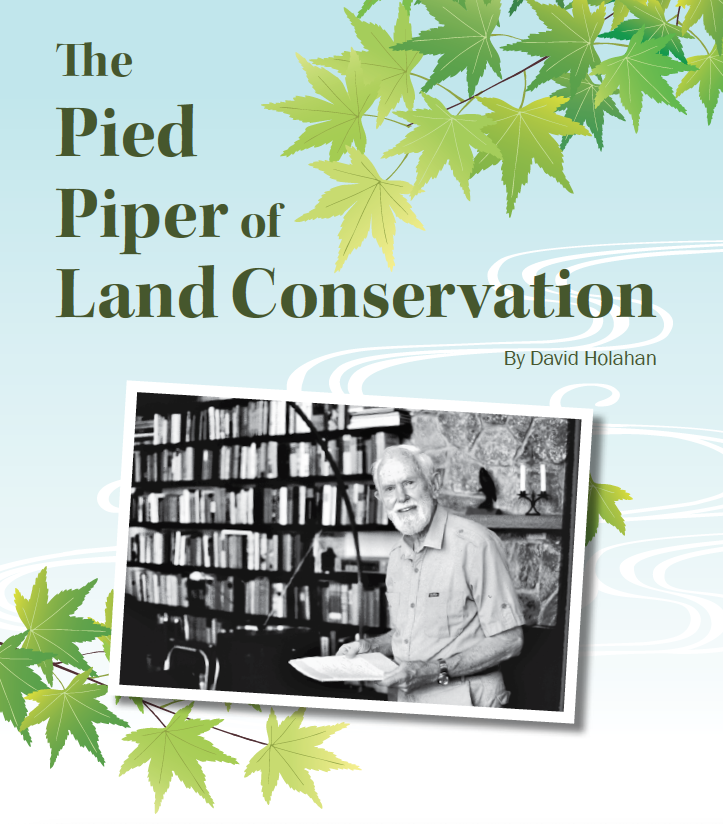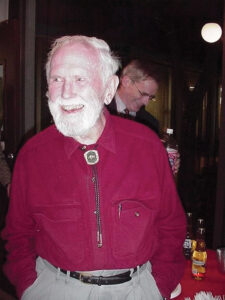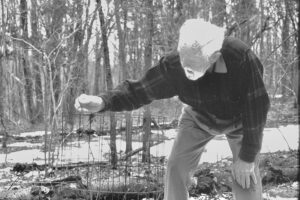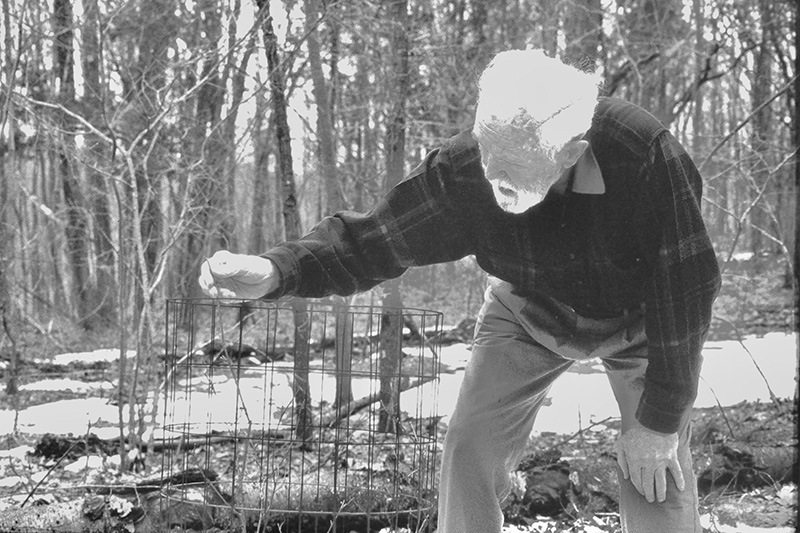
Image Credits: Getty Image/perori 00 (water and leaves background). Judy Preston (Richard Goodwin).
Connecticut, among other places, would not be the same without the vision and determination of Richard Hale Goodwin, the late Connecticut College professor of botany and one of the nation’s pioneering preservationists.
A founder of The Nature Conservancy in 1951 and the East Haddam Land Trust in 1979 (among other organizations), Goodwin pursued a simple mission throughout his long productive life: he identified and studied natural wonders and worked tirelessly to preserve them. Thousands upon thousands of acres from California to the Connecticut River watershed have been set aside thanks to his persistent advocacy.
Remarkably, some acquisitions would take decades, and potential donors could expect periodic calls or visits from Richard as well as a Christmas card from him and his wife, Esther. Goodwin was nothing if not unwavering. He also had a winning personality. He could trot out good stories, and he was a charming and engaging teacher, quietly explaining what a worthy goal preserving land for future generations was.
Goodwin passed away in 2007 at age 96, but a parcel of land he had long had in his sights, near his East Haddam home, recently was set aside for conservation; the landowner credited Goodwin’s gentle persuasion for the belated donation.
Before Goodwin immersed himself in Connecticut preservation projects, he was instrumental in the creation and growth of The Nature Conservancy (TNC), which today is the largest conservation nonprofit in the United States, preserving over 120 million acres worldwide—that’s more than three times the size of New England.
But during its first two decades, the survival of this now ubiquitous organization was anything but certain. Begun by academics who wanted to preserve varied habitats for scientific research, TNC was tiny, broke, and unsure of its mission. In its first four years, it hadn’t set aside a single acre.
On sabbatical from Connecticut College, Goodwin served as the unpaid president of the organization from 1956 to 1958, when its annual budget was a paltry $10,000 and its “staff” consisted of one poorly paid person.
The new president got busy, battling more than a little internal opposition from his fellow scholars. He reorganized and repurposed the nonprofit and pushed for an aggressive land acquisition effort. Preserves wouldn’t just be for scientists. He negotiated the nonprofit’s first major acquisition, 3,000 acres of what he termed “glorious mountain country”: the Northern California Coast Range Preserve. Some of the funding came from the Conservation and Research Foundation that Goodwin and his mother had founded with family resources.
In his second term as president, from 1964 to 1966, Goodwin obtained a $550,000 grant (the equivalent of $6 million today) from the Ford Foundation to pay for a full-time executive director and other staff. Suddenly, things were looking up.

Image Credit: Dave Gumbart
“There are few people who have had as big an impact on land preservation and conservation as Dick Goodwin,” said his Connecticut College colleague Scott Warren. “The Nature Conservancy wouldn’t exist without him. He turned it from a small land trust into a national and then an international conservation organization by the force of his personality and talent.”
Goodwin and his wife, Esther, moved to Connecticut in 1944 after he accepted the position of professor of botany at Connecticut College. In 1956, the couple would buy a 170-acre farm in East Haddam with another couple. Then in 1960, the owners would donate 46 acres of it to be protected in perpetuity—one of the first Nature Conservancy acquisitions in the state. The parcel would serve as an embryo for what is today the 1,122-acre Burnham Brook Preserve, one of the nonprofit’s top three Connecticut properties.
It would not exist today in its pristine state, straddling the Eightmile River—whose entire watershed is now federally designated as “Wild and Scenic”—without his activism and generosity. Indeed, wherever he set his sights, acres upon acres of ecologically valuable land would be set aside.
During his 30-year tenure as director of the Connecticut College Arboretum, the sanctuary grew from 90 to more than 450 acres. He sometimes fronted the deposits with his own money and would then convince college leaders to get on board. “Dick would fundraise outside of official channels. I understand he drove the trustees nuts,” said Scott Warren. “He had tenure. He didn’t care. He was beloved, and he was a great teacher. His enthusiasm, his empathy with his students, was legend.”
Goodwin’s legacy at the college includes establishing a new major, in 1968, now called Environmental Studies, one of the first such offerings nationally in undergraduate education. He was always ahead of the curve when it came to environmental matters.
For all his wide-ranging good works, Goodwin held the Burnham Brook Preserve, near his home in East Haddam, closest to his heart. Over the decades he and his wife would periodically donate valuable pieces of their own land to protect Burnham Brook—where native brook trout can still be found—more than 300 acres all told, including land the couple purchased adjacent to their farm. He also set about convincing his rural neighbors that they should follow his and Esther’s lead; he went door-to-door selling sustainability and stewardship, posing the simple but telling question: “What will happen to the unspoiled land you have enjoyed and cared for all these years when you are gone?”
Today the farm and the house they built there in 1968 are a busy center for preservation in southeastern Connecticut, with a two-mile hiking trail and offices for three collaborating conservation organizations: The Nature Conservancy, the East Haddam Land Trust, and the Eightmile River Wild and Scenic Watershed. A renovated barn is used by area nonprofits for a variety of programming.
“Dick was a soft spoken and gentle person, a quiet coach teaching other people about the importance of land preservation,” said Sue Merrow, who had been the first selectwoman of East Haddam in the 1990s and is the former president of the board of the Sierra Club. “His fingerprints are all over the extraordinary level of protection of land in East Haddam and along the Eightmile River.”
Les Corey was on his second day as State Director of the Connecticut Chapter of The Nature Conservancy in 1986 when Goodwin came calling. “He showed up with all his maps and his plans for protecting Burnham Brook and the Eightmile River Watershed,” Corey recalled. “He was a tenacious advocate, and he always had the boldest vision—and the courage and smarts to back it up. He was a very good negotiator, very good at building relationships with people. If he had been on Wall Street, he would have been a multimillionaire.”
David Bingham, who is on the stewardship committee for Burnham Brook, said Goodwin was innovative in acquiring parcels of land and was one of the first to take advantage of the federal tax deduction, established in 1979, for either donating land outright or protecting it with a conservation easement. The latter option allows the landowner to maintain control and ownership of the property while committing to never developing it.
“It was a novel idea to use the tax deduction for that purpose, and that turned out to be dramatically important,” Bingham said. “He also realized the importance of connecting patches of conservation land, to make isolated parcels part of a larger and more meaningful swath of conserved land. His ideas were fundamentally game-changing in terms of land conservation.”
When Goodwin couldn’t get a landowner to donate a parcel outright or at a bargain price, he would press for a conservation easement. When all else failed, he would start fundraising—or simply pony up family money. In his and his wife’s will, they left the farm to The Nature Conservancy, adding it to the Burnham Brook Preserve. He also left a substantial sum of money to the Community Foundation of Middlesex County, Inc., to support the maintenance of the preserve and its buildings. By his passing, he had connected Burnham with Devil’s Hopyard State Park, thereby creating a 2,000-acre natural corridor in which plants and animals can thrive.
“Dick Goodwin was many things—a botanist, preservationist, co-founder of The Nature Conservancy and especially a visionary,” said Frogard Ryan, State Director of the Connecticut chapter of The Nature Conservancy. “He saw things before the rest of us did, and one thing he saw was the benefit of open space not only to animals and plants but also to people.”
The Burnham Brook Preserve could well be the most studied acreage on the planet. In addition to Goodwin’s voluminous work identifying plants along the banks of the Eightmile River, generations of Connecticut College students have done fieldwork there. Here’s just a taste of what they found: 190 species of birds, 24 fish, 33 mammals, 727 vascular plants, 47 mosses and liverworts, 39 lichens, and 422 fungi.
Goodwin also invited colleagues and local environmentalists to help document the preserve’s flora and fauna. When Burnham Brook went dry one year, he asked then DEEP fisheries biologist Steve Gephart to verify what he assumed was the terrible loss of its native brook trout stock. What Steve and his crew found was that the fish were surviving in what water remained below ground. Remarkably, they would bounce back with the return of the rains.
“Dick taught me so much about terrestrial ecology; I’m glad I got to teach him a little about aquatic biology,” Gephard said.
After retiring from Connecticut College in 1976, Goodwin set about working on expanding the Burnham Brook Preserve full-time—that is, when he and Esther weren’t traveling hither and yon, from the Caribbean to China, South America, and Africa. When home, the Goodwins loved to ramble about Burnham Brook, birding or checking on the various plant species there. He could identify birds simply by their songs, and he was known to cross-country ski through the preserve into his 80s.
Goodwin had little interest in self-promotion, but others have recognized his contributions. The Center for the Environment at Connecticut College bears his name; and in 2016 a new hiking trail, 14 miles long, that connects various conservation parcels running from East Haddam, through Lyme, Salem, and East Lyme, was named for him. It epitomizes his vision of connecting tracts of open space and of how conservation organizations can collaborate on important projects.
In his 2002 autobiography, A Botanist’s View of the Twentieth Century, Richard Goodwin writes: “What I have done in this life has not been motivated by an effort to save myself from unpleasant experiences in the next, but rather, at least in part, by a desire to preserve the beauty and biological integrity of the earth we have inherited.”
He and Esther wrote a poem titled “The Earth is Ours.” The reader soon arrives at this important caveat: “But Just to Share.”
Walking with Dick Goodwin at Burnham Brook
by Judy Preston
Dick and I had been trudging through the woods, me following his lead while listening to his biography of the place. While narrating he would sweep his arm in a direction, referencing boulder-clad hillsides. We crisscrossed slopes, stepped log-to-cobbles across Burnham Brook, traversed the oak ridgeline that would take us, in one direction, back to the house, but not for several more hours.

Dick maintained small cylinders of wire carefully placed around individual plants, his commitment to protecting declining species vulnerable to deer browse. Image Credit: Judy Preston
And there was much to talk about: the early spring pool out in the pasture out of which an enormous blueberry bush—full crowned in the open sun—was thriving; a place just off the trail where he remembered a stand of grey birch, now disappeared into soil, that thrived many years earlier. And the pocket openings of moss, bluestem grass, and, for a few years after a localized fire, a patch of lady slipper orchids, he told me. More than once we would pass “Nodding-Fern Rock,” lodged in a shady and moss-rich bend in the brook, where Dick conveyed the perfect loveliness of a single fern plant whose fronds would be nodding in the cool, moist air rising from the water.
Every assembled parcel of Burnham Brook came with a story, a person, a strategy. They all, of course, shared Dick Goodwin in common, but it wasn’t about him: Dick simply was intent on protecting as much land as possible. He never appeared to be in a hurry so much as having a steadfast, tireless conviction to persist. He embodied the brilliance of community-based conservation—that people will value, and take care of, what they know. His silver bullet was the ability to talk to anyone about why protecting land makes sense.
Toward the end of our particularly long foray through the preserve, Dick stopped to pull a small leather case containing hearing aid batteries from his pocket. I noted that it had been crudely, but sufficiently mended along one seam, and asked if that was his handiwork. He looked up, a bit sheepishly, and with a smile said, “I guess I’m just a thrifty dam Yankee.”
It was that same Yankee spirit that I saw in action coming home one late afternoon along Route 82; I slowed when I saw two people hunched behind the open hatch of a maroon Volvo station wagon pulled over at the side of the road. Dick and his wife Esther—then in their mid-80s, were attempting to lift a muddy tire into the back, where other trash and debris had already been collected, pulled from the margins of a wetland. “We just got tired of seeing it here.” A simple solution to an annoyingly common problem, with the difference being the steadfast, tireless conviction to fix it.
Judy Preston worked for the Connecticut Chapter of the Nature Conservancy as Director of Science and Stewardship in the 1990s and was a frequent visitor to Burnham Brook.

